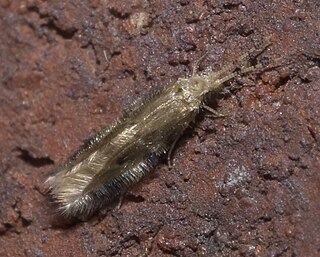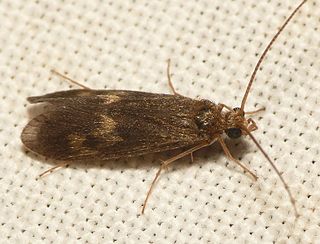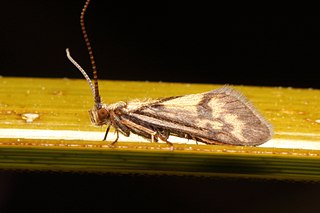
The Cupedidae are a small family of beetles, notable for the square pattern of "windows" on their elytra, which give the family their common name of reticulated beetles.

Mose John Allison Jr. was an American jazz and blues pianist, singer, and songwriter. He became notable for playing a unique mix of blues and modern jazz, both singing and playing piano. After moving to New York in 1956, he worked primarily in jazz settings, playing with jazz musicians like Stan Getz, Al Cohn, and Zoot Sims, along with producing numerous recordings.

The family Leptoceridae are a family of caddisflies often called "long-horned caddisflies" or "silverhorns". Leptoceridae is the second largest family of caddisflies with over 1850 species in approximately 68 genera. The main identifying feature of most Leptoceridae is that their antennae are much longer than those of other caddisflies. There is one genus with relatively short antennae (Ceraclea), but it is easily identified by the pair of dark curved lines on the mesonotum.

Fort Mose, originally known as Gracia Real de Santa Teresa de Mose, and later as Fort Mose, or alternatively, Fort Moosa or Fort Mossa, is a former Spanish fort in St. Augustine, Florida. In 1738, the governor of Spanish Florida, Manuel de Montiano, had the fort established as a free black settlement, the first to be legally sanctioned in what would become the territory of the United States. It was designated a US National Historic Landmark on October 12, 1994.

The Hydroptilidae are a large family of caddisflies (Trichoptera) with a worldwide distribution. They are commonly known as microcaddisflies or purse-case caddisflies, in reference to two characteristic traits of this family: Hydroptilidae are much smaller than other caddisflies, rarely exceeding 5 mm (0.20 in) in length. Their larvae do not build a protective case until the final instar of their growth. At that time however, they build a typically Purse-shaped case, either portable or stuck to the substrate, in which the larva finishes growth and pupates.

The Polycentropodidae are a family of trumpet-net and tube-making caddisflies. There are at least 30 genera and 720 described species in Polycentropodidae. The type genus for Polycentropodidae is Polycentropus J. Curtis, 1835.
Adinolepis is a genus of beetles in the family Cupedidae containing four species, all endemic to Australia. A fifth species, Adinolepis scalena, was transferred to Ascioplaga in 2009.

Rhipsideigma is a genus of beetles in the family Cupedidae. It contains five species, four of which are endemic to Madagascar, the other being endemic to the northern coast of Tanzania. They vary in length from 13 mm to 20 mm, and are up to 6 mm wide.

Tenomerga is a genus of beetles in the family Cupedidae. This genus has about 17 extant species, which are native to the eastern Palearctic, Nearctic and Oriental regions.
Distocupes is a monotypic genus of beetles in the family Cupedidae, the reticulated beetles. It contains the single species Distocupes varians. It is endemic to eastern Australia, including Tasmania. It is about 12 millimeters long and dark brown to black in color with a coat of lighter scales. Little is known about its biology.
Kokiriidae is a family of insect in the order Trichoptera. It was discovered in 1964 and is found in Australia, Chile, New Caledonia, and New Zealand. It consists of fifteen species and six genera.

Hydroptilinae is a subfamily of microcaddisflies in the family Hydroptilidae. There are at least 60 genera and 1,600 described species in Hydroptilinae.

Diplectrona is a genus of netspinning caddisflies in the family Hydropsychidae. There are a large number of species within Diplectrona. Catalogue of Life and Integrated Taxonomic Information System accept 87 species, while others, including Global Biodiversity Information Facility, accept more than 100 described species.
Aolar Carson Mosely was an American artist. She was a founding member of the Freedom Quilting Bee, and is associated with the Gee's Bend quiltmakers, along with her daughter Mary Lee Bendolph and her granddaughter Essie Bendolph Pettway. Almost all of her quilts were destroyed when her house burned down in 1984.

Conoesucidae is a family of caddisflies in the order Trichoptera. There are about 12 genera and more than 40 described species in Conoesucidae.
Philorheithridae is a family of caddisflies in the order Trichoptera. There are about 8 genera and more than 20 described species in Philorheithridae.










